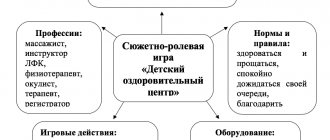Independent work of children, forms of its organization
Detsky sad.Ru >> Electronic library >> Books on pedagogy and psychology >> “Preschool pedagogy”. Ed. V. I. Loginova, P. G. Samorukova Textbook for pedagogical students. Institute for specialties “Preschool. pedagogy and psychology". Publishing house "Prosveshchenie", M., 1983 OCR Detskiysad.Ru The book is given with some abbreviations.
Independent work of children is the most effective means of labor education, the introduction of which is prepared by labor training.
The importance of children’s independent work is that the child masters labor activity; independent work of children is a school for the child’s participation in socially useful activities, a school for mastering social motives of work, a school for effectively caring for people, a school for mastering socially valuable forms of behavior. However, as A. S. Makarenko rightly argued, work can remain neutral in its educational impact if you do not care about the forms of its organization. In preschool institutions, two forms of organizing the daily independent work of children are used - individual work of children and collective work. When organizing labor in the indicated forms, objective conditions are created for the implementation of all tasks of labor education: the formation of labor activity, the education of the child’s personality and the education of an attitude towards work, its result and the working person. The task of the educator is to make maximum use of the possibilities of individual and collective work in order to raise children. Individual work as a form of organizing the daily work of children is widely used in all age groups of kindergarten and in all types of work activities. This form of organization is characterized by the fact that the entire labor process is performed by the child individually; he is not associated with any of the children in any element of his work activity. This circumstance creates favorable conditions, firstly, for the child to understand the social orientation and social significance of the result of his work (he arranged the bread bins correctly - helped the nanny and took care of all the children), and secondly, for the successful development of effective actions, and then labor processes under the guidance of an adult. The most effective form of individual work is in younger groups, where close contact between the child and the teacher is especially important when mastering work activities. The teacher has the opportunity to provide the necessary attention to each child, help in the most difficult moments, determine an individual pace, the required number of exercises to master complex content. In addition, an adult can explain in detail the purpose and significance of the child’s work for others, ensure acceptance of the goal, interest in the result of the work, and create a desire to achieve it. Here, opportunities are created for an individual approach to the child: to explain and show the result of work, the requirements for it, to conduct a thorough demonstration of labor actions, to provide direct assistance to the child in the form of so-called passive actions - actions with the child’s hands. Ensuring the mastery of labor actions, the teacher breaks them down into operations, practicing their component movements: first, with both hands from below, take a plate of bread, and then, when this movement is completed, place it in the center of the table. Thus, demonstrations, explanations, and the child’s own actions alternate, and each time the child repeats the labor action more and more accurately, achieving the desired result. Mastery of work actions is the basis for the development of a child’s activity, caring for others, desire and ability to help a peer. Thus, already 3-year-old children, having mastered the labor tasks of fastening, unfastening or laying out spoons, willingly help either their peers in the process of dressing, or the nanny in setting the table. In the middle and older groups, individual labor is used to help children master labor processes. When guiding him, an explanation of the purpose of work, requirements for the result is also used, a thorough demonstration of the organization of the labor process, labor actions, and their sequence is carried out. But in these groups, instructions and advice based on previously formed knowledge and skills are gaining more and more weight, although in especially difficult cases it is possible to return to working out the labor process in parts. In senior and preparatory groups, demonstration is used when new work techniques are included or if the child, due to a number of circumstances, has not mastered the necessary skills in previous groups. In the individual work of children in the middle group and older groups, special attention is paid to careful monitoring of the accuracy of actions, the quality of the result, the accuracy of the work, control over the pace of work, and the child’s efficiency. The child himself is involved in assessing the result, whom the teacher teaches to see the reasons for success and failure in performing each work action. In older groups, the individual work of children is both an indicator of the child’s interest in one or another type of labor (manual, outdoor labor, or household work) and an indicator of his formation. In this case, the child, as a rule, has a fairly good command of the labor process. The teacher comes to the rescue with advice, questions, guides the analysis of the result, suggesting what needs to be improved and how. As children master labor processes, it becomes possible to organize the work of several children nearby. It occurs in the younger group and is characterized by the fact that children work in parallel: each performs their own task, works at their own pace, with their own equipment, and reports for their results. Working nearby makes it possible to simultaneously manage the activities of several children, performing a general demonstration of some technique or giving advice and instructions to all children. In the course of work nearby, especially if its content is the same, communication may arise between children about the pace, quality of work, equipment, etc. The teacher uses these opportunities to develop relationships among children: to provide help or not to interfere with a friend, to share equipment, etc. d. Working side by side is a transitional step to collective work. Already at preschool age, collective work of children with its characteristics is possible: a common goal, division of labor between workers, a collective result of labor, shared responsibility for it, dependence of labor participants on each other. In collective work, objective conditions arise for the emergence of mutual assistance, mutual demands, mutual responsibility, etc. The simplest form of organizing collective work is common work, which is characterized by the unification of children in two elements of activity: a common goal and generalization of the results of the work of all participants into one common result. The labor process proceeds as an individual one. For example, a common goal is to make plants clean. Each of the children receives one plant and wipes it. The overall result is that everyone together made all the plants clean. The content of tasks in the general work can be different for each child: one wipes chairs, another wipes shelves, a third lays building material, etc. The overall result is order and cleanliness in the group. Generalization of the results makes it possible for each child to feel like a member of a working group, and for the teacher to form in children an idea of the collective nature of work and an understanding of the dependence of the overall result of work on the quality of each person’s work. Such associations arise already in early and middle preschool age, when some children have mastered individual labor processes or productive labor actions included in the labor process. In managing common work, the teacher faces two types of tasks: 1) the formation of collective work - work activity, relationships and communication between children about work; 2) determination of methods and techniques that allow one to develop a child’s personality in the process of collective work. Common work begins with the teacher setting a common goal and determining the amount of common work, explaining why work can be done by a group of children, for example: “We have a lot of work: we need to wash all the doll dishes (dirty doll dishes are prepared and put in one place so that there really is a lot of it).” Then follows the distribution of the amount of work: “Everyone will wash one item, and all the dishes will be clean.” After this, the children select equipment and each organize their own workplace. Having received permission, they take the dishes, wash them, rinse them, and place them on a napkin on the common table. The result is assessed in terms of the quality of work and its volume. Over time (by the end of the year in the middle group), the teacher involves children in performing various labor processes in general work, in the distribution of work, clarifying its purpose, volume and necessary equipment. At the same time, the inclinations and skills of the children are taken into account: each chooses a more interesting job for himself and one in which he has better mastered labor actions. A fair distribution of work requires taking into account its volume, the desires of the children and the order in which more attractive work is performed (last time Sasha watered the plants, and now Kolya will do it, and Sasha will wipe, arrange chairs, etc.). At first, the shared work covers a small group of children, and then the group as a whole. As you master labor processes and the ability to work together, the nature of the organization of this form of labor becomes more complex. The total volume of labor is no longer distributed among working children, but between units. Each link performs a different job: one link, participating in cleaning the group room, wipes and waters the plants, the second wipes the chairs, the third washes the toys. Moreover, each child in the unit performs the entire labor process himself in relation to several objects. When distributing work between units, the teacher takes into account the children’s preparedness to complete the task and explains why this work is assigned to this unit. It is important that children improve in various work processes. When distributing children among units and labor between units, the complexity of the work is taken into account: each unit must have the same amount of work. When determining the composition of the links, the teacher takes into account the desires of the children and their mutual influence. A person who knows how to work well should not suppress someone who has worse work skills, and he, in turn, learns to work quickly from others. Here, partnerships are formed, the ability to help, to yield, etc. The teacher actively manages this process, paying special attention to the quality of work and relationships between children. Taking into account the level of development of work skills, the teacher regulates the workload of each child: a more skilled child receives a slightly larger amount of work, or a child who has coped with the work helps another. The work ends with summing up the general results. The overall result of work is realized by children only with the help of an adult, who combines the results of everyone’s work, showing the importance of collective efforts: “Each wiped 3 chairs, and everyone did a lot together” or “Everyone cleaned the group room together - wiped the chairs, washed the toys, washed and watered the plants.” The teacher also indicates the direction of the work - for what or for whom the children are working. Such explanations create a desire to work more diligently. The nature of the relationships that arose during the work is also assessed: “Petya helped Sasha - he showed how to properly wipe the leaves. Petya did a good job.” Such assessments form children’s ideas about the norms of relationships, which is important for further assessment, self-esteem and regulation of their behavior by the child himself in the process of collective work. At the end of collective work, it is obligatory for each child to clean his or her own workplace and equipment. Joint work involves isolating a series of sequential actions on an object of labor, passing from one participant to another, and is organized in older preschool age. Each participant takes his place in the chain: he accepts the object of labor, performs his labor action and passes the object on. Children are united by the common goal of work, the facts of acceptance and delivery of the product by each participant, and the final result, which accumulates the labor efforts of all participants. Joint work gives each child the opportunity to feel like a member of the community, to feel the importance of joint efforts to achieve results, the need for everyone to do their job conscientiously and at a common pace. This organization is most appropriate for labor processes that can be divided into a number of sequential labor actions with a clearly defined intermediate result: cleaning of large building materials (delivery of material, washing, wiping, putting in place - 4 labor actions); crafting toys from paper (folding patterns, gluing, gluing decorations - 3 steps); clearing snow on the site or cleaning the site (raking snow in one place, filling boxes with snow, transporting to building sites - 3-4 steps); work in the garden (clearing beds of debris, digging up soil, leveling the ground with a rake), etc. The number of labor actions in the chain should not exceed 3-4. As the chain increases, children are unable to cover the entire labor process and correctly determine the sequence of actions. The volume of labor action should be within the capabilities of each participant, and the division of labor into operations is understandable to the child and convenient for work. When dividing the labor process, it is important to ensure that each labor action ends with a fairly pronounced intermediate result that meets certain requirements: bring the building material and fold it so that it is convenient to take it for washing; wash and rinse parts so that they are clean; wipe dry on all sides and put different parts on different shelves, etc. These requirements must be controlled by the participants in the work. Collaborative work requires clear organization. A special consistent way of performing work requires knowledge about the composition and order of labor actions. Children gain this knowledge in the process of familiarizing themselves with the work of adults (tailoring in an atelier, building a house, preparing food by chefs, etc.), when they find out that the consistent division and execution of labor actions speeds up the receipt of the finished product and improves its quality, since everyone knows how to do their job quickly and well. Before starting to work together, children remember the composition and sequence of actions in the upcoming work process. During the conversation, it is discussed how many children should participate in the labor process, what actions and in what sequence each participant will perform, and what equipment he needs. Such preliminary discussion helps to properly plan and organize collective work. By directing the joint work of children, the teacher solves two problems: the formation of collective work and the education of the child’s personality in the process of work. This guide is made up of a number of points. Preliminary discussion - planning of work: having determined the purpose of work and highlighting work actions, children agree on who will do what and how many children will perform this or that action, based on its labor intensity. For example, washing cubes takes less time than wiping, which means that if two people wash the cubes, then three will do the drying. Such a discussion forms in children an idea of the amount of labor and its fair division, taking into account complexity. Conflicts are also possible here if several children want to perform the same more interesting action. The teacher teaches how to resolve conflicts by agreeing on the order of performing more interesting work activities. Discussion of workplace organization: what equipment is needed, how to arrange it to make it convenient to work. With such training in work planning, the independence of children sharply increases: they themselves distribute the participants in the work, each choosing a place for themselves, taking into account the desires of other children, the complexity of individual actions and their skills. But this independence is formed gradually in everyone. Children are identified as initiators who, knowing well the composition and sequence of labor actions in labor processes, take the initiative to distribute work participants to places. Others ask the initiators what to do and do not immediately get involved in the work. The role of the educator is to introduce rules on the basis of which responsibilities are distributed fairly (following the principle of priority, taking into account desires, work skills, etc.). By mastering the rules, children become more and more independent in organizing and performing work. In this case, the role of the teacher is to assess the children’s self-organization after graduation. In the process of organizing work, it is important to consider the nature of involving all children in work. Those children who are included in the work in the latest operations can help those who perform the first operations (for example, bring cubes for washing), or prepare a place for “products” (wipe the shelves on which the building material will be laid, etc. .). And then the children who performed the first operations help those who complete the work. Such an approach to the activities of children allows you to immediately organize labor correctly and manage the activities of all participants, at the same time showing them the rules for regulating relations in the labor process. The causes of conflicts are insufficient skills of children, inattention to the quality of their work. The ways to eliminate these conflicts are different. In the first case, knowledge of the capabilities of each participant in the chain is required. A show or other method of teaching a child in the course of such work is impossible, since temporary pauses destroy the work of all. If the child owns the labor action, but the pace of work is insufficient, he needs to help: to recall, advise more rational ways to perform the operation or transfer part of the work to a skilled child or increase the number of children to perform this labor action. In the second case, the teacher draws the attention of all children to the quality of the intermediate result, introduces the rule - to hand over the work (object) to the next participant only with a good result, supports those children who seek to do everything well and require the same from other participants; Helps those who do not cope with the work entrusted to him. When assessing the result of labor, the teacher connects it with the labor efforts of all children, the quality of intermediate results. The assessment also contains a reminder of the goals, the orientation of labor, which is important for consolidating socially significant motives for their activities in the minds of the child. One of the varieties of joint work is characterized by the fact that at the same time two (or more) children perform one labor effect with one subject of labor: carrying dry leaves on a stretcher, moving (carrying) tables, folding tablecloths, some types of carpentry, when one child, for example, for example It saws, the other holds a piece of wood, etc. This type of labor is complicated for children by the fact that in the process it is important to be able to strictly coordinate their actions with the actions of another participant, to fulfill them at the same time. The leadership of such labor includes: 1) the explanation of the need for joint labor actions: the tables are heavy, one cannot transfer them, you need to do this together, etc.; 2) showing children of joint work, consistency of efforts (how to stand up to the handles of a stretcher, how and why it is important to raise the stretcher at the same time, how to tilt them at the same time in order to drop the load, etc.); 3) the implementation of certain rules that prevent the occurrence of conflicts: to expect a comrade, take into account its pace, etc. Thus, individual and collective work is widely used in all groups of kindergarten in order to labor education of children, while the dynamics of the organization is characterized by the transition from individual work, together with an adult to individual independent work and work nearby, and then to collective work. But collective work does not cancel individual labor in older preschool age. continuation of the book...




